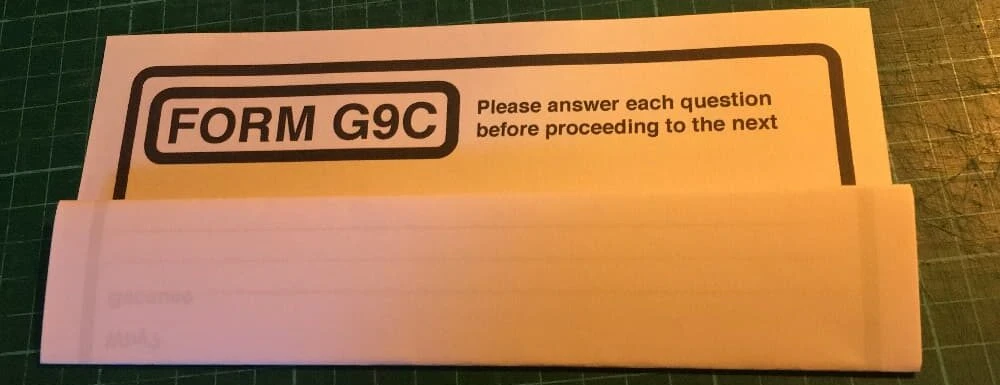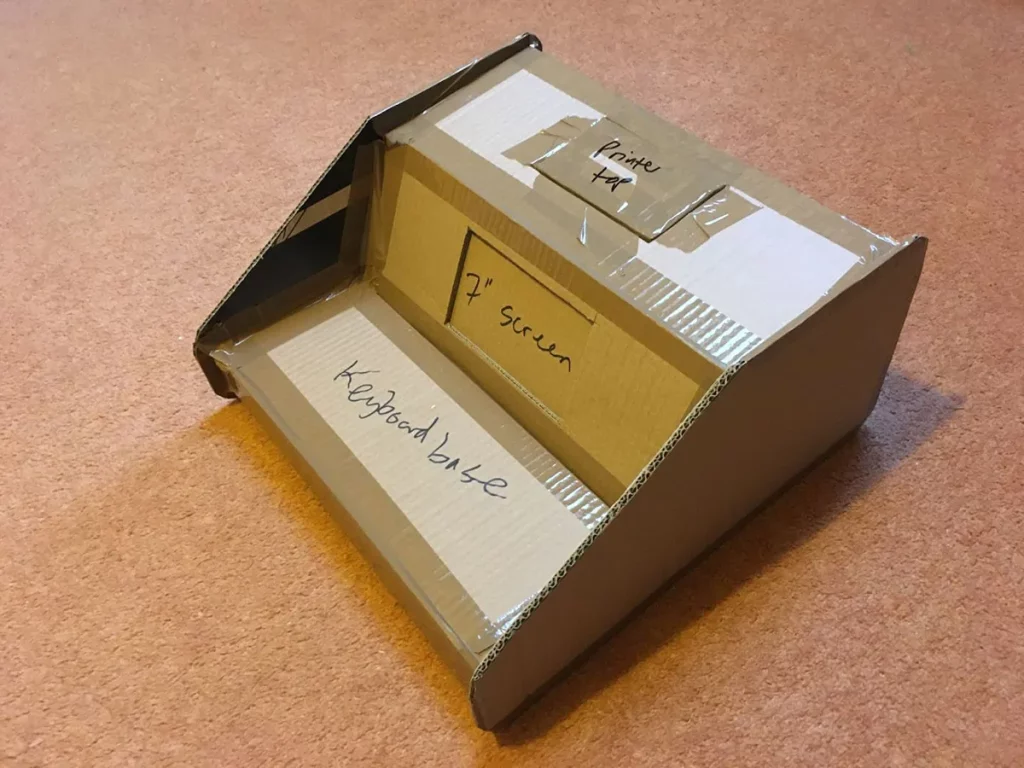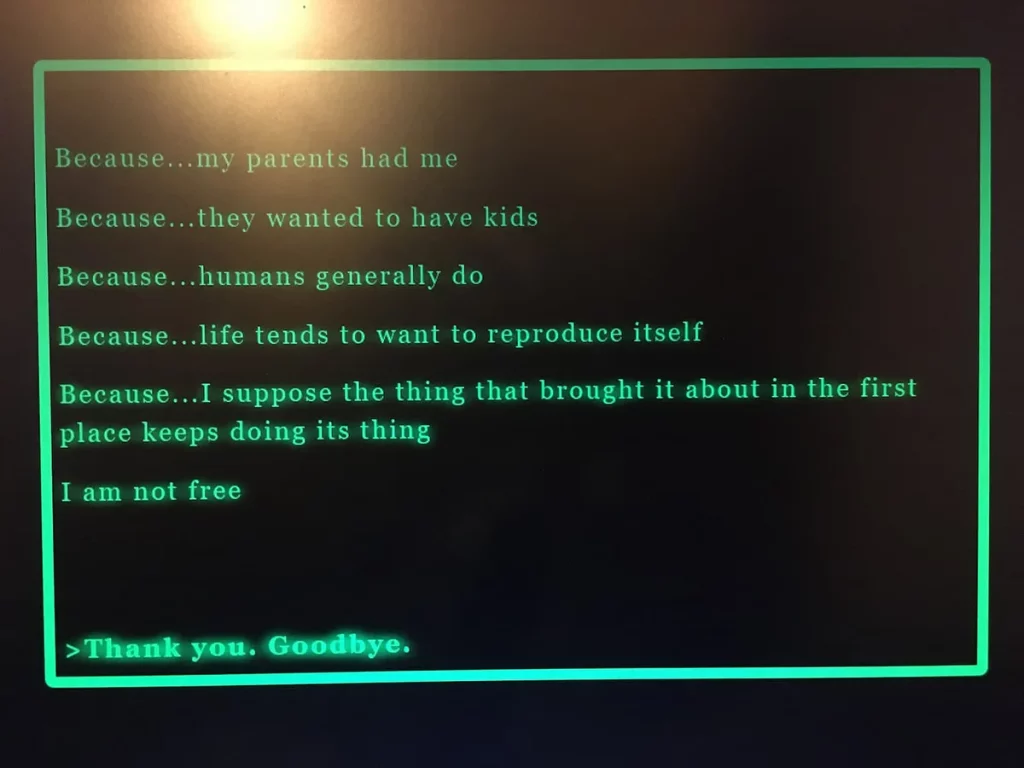As part of the Poetry Games exhibition, the National Poetry Library supported the launch of two micro-commissions. Each one was an opportunity for a poet or artist to explore their own work in the context of playful arts, and see how interactivity or game-design might take their practice in a new direction.
For this commission, artist Geraint Edwards looked at the notion of free will and how the nature of questioning of leave a poetic afterimage. The piece, conceived as a physical object, and the game elements tested through digital and physical experiments such as Twine and pen and paper prototyping.
Geraint writes about the process below:
Curiosity
For this micro-commission I wanted to develop an idea I’ve had knocking around for a while now – it’s something I’d really like to finally get built and hopefully learn some new powers along the way.
It’s a very simple idea. The player is asked a very general opening question (e.g. How did you get here today?) and they write a short response – they can interpret the question however they want. Once they’ve submitted their reply, they are asked “Why?”. They give a short explanation for their answer as they see it, and then are asked again: “Why?”. This continues 4 or 5 times, in the way that an inquisitive young child might keep asking “Why?”, with the player giving more explanation that each time takes a step away from the original question, backing downwards along the line of causality. Who knows where that line will take them – it might be up to galactic scale, or down to molecular structure, or it might be back to the bus stop.
When they’ve given their answer to the final “Why?”, they are asked: “Do you have free will?”
This small twist should give the player a bit of a wobble, as they look back through their responses and reflect on whether their conscious view on free will and the answers they’ve given align or not. It’s not supposed to suggest that they’re wrong, that there is a correct answer, or that they’ve been tricked. It’s a mirror, prompting a reflection on how they see the world. In a world of mirrors that lie, true mirrors are important.
A printout of their responses would be a nice way to end it and give them a text to consider, whether they agree with it or not.


Results
Understandably, there was a huge range in the amount of detail that people gave and how much people were genuinely trying to explain the reasons behind their answers. Clearly with this kind of thing, what you put in, you get out, and some people really explored the steps backwards through the cause/effect relationships. Some people gave shorter answers and maybe got something very different out of the experience. Not everybody is going to want to declare their thoughts on how they see the world, their place within it and feelings of agency. It’s quite an exposing thing to do, and by asking them these questions, you are asking them to make themselves vulnerable.
Some artworks elicit incredible responses from people with the most basic materials and set-up (e.g. Gillian Wearing’s Signs that Say What You Want Them To Say and Not Signs that Say What Someone Else Wants You To Say). I don’t expect everyone to feel inclined to expose their inner thoughts, but I can try to lessen the friction as much as possible.
Problem
- Getting vague/brief answers because people are not committed
Why?
- Not directed enough
- The purpose isn’t explained
- Vulnerability – don’t want to write personal stuff
- What’s in it for them?
- What’s the goal? Unclear.
Motivations
- Player gets something at the end
- Player finds something out
- Player is entertained
- Player is inclined to help someone who asks for help
- Player is trying to avoid losing
Solutions
- Players type answers (more private than telling a stranger or speaking them into a text-to-speech machine)
- Maybe they can know it’s about free will at the start?
- Can we make the questions more engaging without leading the player / ruining the (essential) self-direction aspect?
- Make it more personal – the questioner is more relatable and communicates in a way that encourages the player.
- The questioner is low status, requesting help. The player (high status) is imparting their wisdom.
This got me thinking about flipping it. The player plays the role of an AI, sitting inside the box. Answering the questions for the humans. (But – this is too demanding on the player).
Form
To coax the player into more complete or thoughtful answers, the questioner could be a young child, an alien intelligence trying to understand the world it has found, or an artefact from another time trying to orient itself to where it has landed. I feel a key part of convincing people to take part is that they can see that someone else has given weight to it (time and effort has gone into creating it / thought has gone into materials and production). When you’re expecting quite a lot from someone in terms of their input, it’s expected that you might need to lead them right up to the door. Then knock on the door. And run away. Let them deal with the consequences.
I started this process thinking the object should be something that isn’t immediately recognisable; something that could be from another time or another world, made from materials that make it hard to place, giving it the quality of an outsider that you might believe does not understand the way this world works and be inclined to help it understand. Then Nick asked for a sketch and my ideas obviously thudded back down to earth. It’s quite hard to build something that couldn’t possibly physically exist. I decided that you can either distance something by displacing it in time or space, and that it’s easier to portray being from another time than another world. Then, the functional requirements: if you need to type your answers you need a keyboard; you need a screen to see what you’ve typed (and read the questions), and you need a thermal printer for the printout – pretty soon it’s turned into an electric typewriter. I like making things out of wood, and it would be nice to build a unique object to house the questioner (I’m thinking of “Curiosity” as a name – it sets up the relationship as inquisitive rather than interrogation and adds the dimension of space travel – maybe Mars sent one back again).
I built a cardboard version to see what dimensions it would need to be to hold the various components.

Text
I had fun looking at a couple of examples that Nick suggested to explore how you might frame questions to avoid less focused answers and guide the responder (A Visit to San Sibilia & Forget-Me-Not: Myosotis). I built a version in Twine that you can try here.
I also built a Twine version which flips the free will question to the start and has a very different outcome if you click “No” to the “Do you have free will?” question. Try that version here.
SO.
I quite like the “No” branch with the dictated answers – it makes that answer more satisfying.
However, having the free will question at the start means that the “Yes” branch ends without the twist and finishes without any impact. So it either needs a different ending to give it an equal power to the “No” branch, or I need to abandon the “No” branch and go back to the original twist of the free will question at the end. I’d love to hear any thoughts on your experiences with the different versions.

The Playing Poetry Micro-commission is supported by The National Poetry Library and took place as part of the Poetry Games exhibition (Southbank Centre, October 2022 – January 2023)